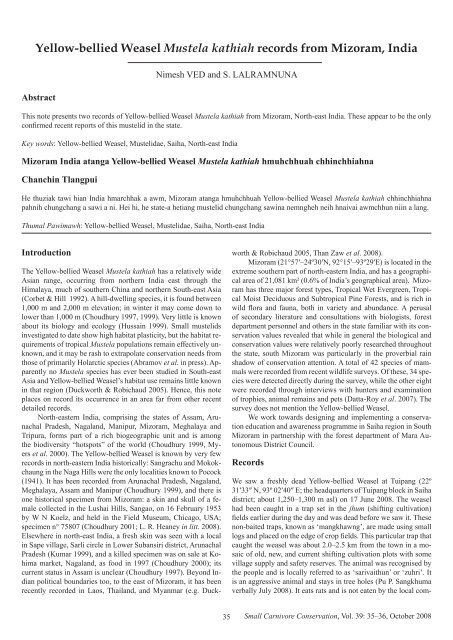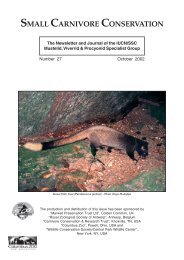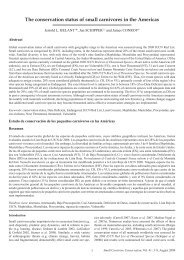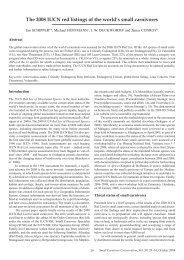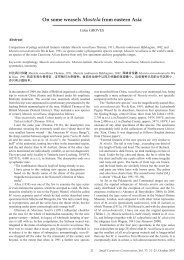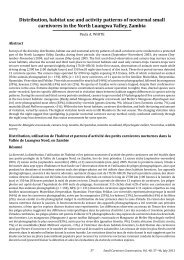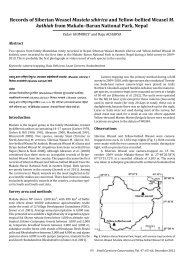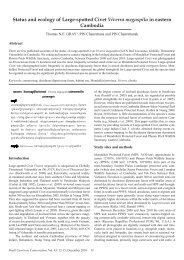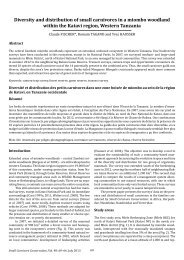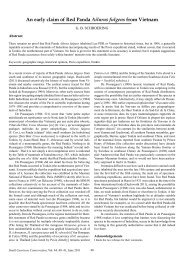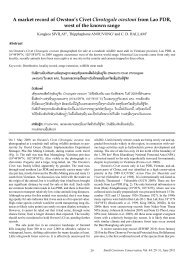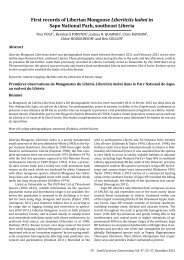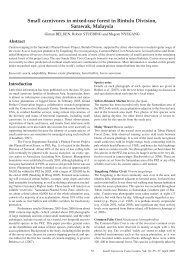Yellow-bellied Weasel Mustela kathiah records from Mizoram, India
Yellow-bellied Weasel Mustela kathiah records from Mizoram, India
Yellow-bellied Weasel Mustela kathiah records from Mizoram, India
You also want an ePaper? Increase the reach of your titles
YUMPU automatically turns print PDFs into web optimized ePapers that Google loves.
<strong>Yellow</strong>-<strong>bellied</strong> <strong>Weasel</strong> <strong>Mustela</strong> <strong>kathiah</strong> <strong>records</strong> <strong>from</strong> <strong>Mizoram</strong>, <strong>India</strong><br />
Abstract<br />
Introduction<br />
The <strong>Yellow</strong>-<strong>bellied</strong> <strong>Weasel</strong> <strong>Mustela</strong> <strong>kathiah</strong> has a relatively wide<br />
Asian range, occurring <strong>from</strong> northern <strong>India</strong> east through the<br />
Himalaya, much of southern China and northern South-east Asia<br />
(Corbet & Hill 1992). A hill-dwelling species, it is found between<br />
1,000 m and 2,000 m elevation; in winter it may come down to<br />
lower than 1,000 m (Choudhury 1997, 1999). Very little is known<br />
about its biology and ecology (Hussain 1999). Small mustelids<br />
investigated to date show high habitat plasticity, but the habitat requirements<br />
of tropical <strong>Mustela</strong> populations remain effectively unknown,<br />
and it may be rash to extrapolate conservation needs <strong>from</strong><br />
those of primarily Holarctic species (Abramov et al. in press). Apparently<br />
no <strong>Mustela</strong> species has ever been studied in South-east<br />
Asia and <strong>Yellow</strong>-<strong>bellied</strong> <strong>Weasel</strong>’s habitat use remains little known<br />
in that region (Duckworth & Robichaud 2005). Hence, this note<br />
places on record its occurrence in an area far <strong>from</strong> other recent<br />
detailed <strong>records</strong>.<br />
North-eastern <strong>India</strong>, comprising the states of Assam, Arunachal<br />
Pradesh, Nagaland, Manipur, <strong>Mizoram</strong>, Meghalaya and<br />
Tripura, forms part of a rich biogeographic unit and is among<br />
the biodiversity “hotspots” of the world (Choudhury 1999, Myers<br />
et al. 2000). The <strong>Yellow</strong>-<strong>bellied</strong> <strong>Weasel</strong> is known by very few<br />
<strong>records</strong> in north-eastern <strong>India</strong> historically: Sangrachu and Mokokchaung<br />
in the Naga Hills were the only localities known to Pocock<br />
(1941). It has been recorded <strong>from</strong> Arunachal Pradesh, Nagaland,<br />
Meghalaya, Assam and Manipur (Choudhury 1999), and there is<br />
one historical specimen <strong>from</strong> <strong>Mizoram</strong>: a skin and skull of a female<br />
collected in the Lushai Hills, Sangao, on 16 February 1953<br />
by W N Koelz, and held in the Field Museum, Chicago, USA;<br />
specimen n° 75807 (Choudhury 2001; L. R. Heaney in litt. 2008).<br />
Elsewhere in north-east <strong>India</strong>, a fresh skin was seen with a local<br />
in Sape village, Sarli circle in Lower Subansiri district, Arunachal<br />
Pradesh (Kumar 1999), and a killed specimen was on sale at Kohima<br />
market, Nagaland, as food in 1997 (Choudhury 2000); its<br />
current status in Assam is unclear (Choudhury 1997). Beyond <strong>India</strong>n<br />
political boundaries too, to the east of <strong>Mizoram</strong>, it has been<br />
recently recorded in Laos, Thailand, and Myanmar (e.g. Duck-<br />
Nimesh VED and S. LALRAMNUNA<br />
This note presents two <strong>records</strong> of <strong>Yellow</strong>-<strong>bellied</strong> <strong>Weasel</strong> <strong>Mustela</strong> <strong>kathiah</strong> <strong>from</strong> <strong>Mizoram</strong>, North-east <strong>India</strong>. These appear to be the only<br />
confirmed recent reports of this mustelid in the state.<br />
Key words: <strong>Yellow</strong>-<strong>bellied</strong> <strong>Weasel</strong>, Mustelidae, Saiha, North-east <strong>India</strong><br />
<strong>Mizoram</strong> <strong>India</strong> atanga <strong>Yellow</strong>-<strong>bellied</strong> <strong>Weasel</strong> <strong>Mustela</strong> <strong>kathiah</strong> hmuhchhuah chhinchhiahna<br />
Chanchin Tlangpui<br />
He thuziak tawi hian <strong>India</strong> hmarchhak a awm, <strong>Mizoram</strong> atanga hmuhchhuah <strong>Yellow</strong>-<strong>bellied</strong> <strong>Weasel</strong> <strong>Mustela</strong> <strong>kathiah</strong> chhinchhiahna<br />
pahnih chungchang a sawi a ni. Hei hi, he state-a hetiang mustelid chungchang sawina nemngheh neih hnaivai awmchhun niin a lang.<br />
Thumal Pawimawh: <strong>Yellow</strong>-<strong>bellied</strong> <strong>Weasel</strong>, Mustelidae, Saiha, North-east <strong>India</strong><br />
35<br />
worth & Robichaud 2005, Than Zaw et al. 2008).<br />
<strong>Mizoram</strong> (21°57′–24º30′N, 92°15′–93º29′E) is located in the<br />
extreme southern part of north-eastern <strong>India</strong>, and has a geographical<br />
area of 21,081 km² (0.6% of <strong>India</strong>’s geographical area). <strong>Mizoram</strong><br />
has three major forest types, Tropical Wet Evergreen, Tropical<br />
Moist Deciduous and Subtropical Pine Forests, and is rich in<br />
wild flora and fauna, both in variety and abundance. A perusal<br />
of secondary literature and consultations with biologists, forest<br />
department personnel and others in the state familiar with its conservation<br />
values revealed that while in general the biological and<br />
conservation values were relatively poorly researched throughout<br />
the state, south <strong>Mizoram</strong> was particularly in the proverbial rain<br />
shadow of conservation attention. A total of 42 species of mammals<br />
were recorded <strong>from</strong> recent wildlife surveys. Of these, 34 species<br />
were detected directly during the survey, while the other eight<br />
were recorded through interviews with hunters and examination<br />
of trophies, animal remains and pets (Datta-Roy et al. 2007). The<br />
survey does not mention the <strong>Yellow</strong>-<strong>bellied</strong> <strong>Weasel</strong>.<br />
We work towards designing and implementing a conservation<br />
education and awareness programme in Saiha region in South<br />
<strong>Mizoram</strong> in partnership with the forest department of Mara Autonomous<br />
District Council.<br />
Records<br />
We saw a freshly dead <strong>Yellow</strong>-<strong>bellied</strong> <strong>Weasel</strong> at Tuipang (22º<br />
31′33″ N, 93º 02′40″ E; the headquarters of Tuipang block in Saiha<br />
district; about 1,250–1,300 m asl) on 17 June 2008. The weasel<br />
had been caught in a trap set in the jhum (shifting cultivation)<br />
fields earlier during the day and was dead before we saw it. These<br />
non-baited traps, known as ‘mangkhawng’, are made using small<br />
logs and placed on the edge of crop fields. This particular trap that<br />
caught the weasel was about 2.0–2.5 km <strong>from</strong> the town in a mosaic<br />
of old, new, and current shifting cultivation plots with some<br />
village supply and safety reserves. The animal was recognised by<br />
the people and is locally referred to as ‘sarivaithun’ or ‘zuhri’. It<br />
is an aggressive animal and stays in tree holes (Pu P. Sangkhuma<br />
verbally July 2008). It eats rats and is not eaten by the local com-<br />
Small Carnivore Conservation, Vol. 39: 35–36, October 2008
Ved and Lalramnuna<br />
munity on account of its pungent smell, so is instead thrown away<br />
(Pu Lambu and Pu J. Biakmawia verbally June 2008). It is therefore<br />
a by-catch in the traps primarily set for catching squirrels,<br />
rats, and civets. These traps are laid for procuring meat and at the<br />
same time get rid of crop pests. We were able to take close photographs<br />
of the weasel body, which was wet with rain (Fig. 1). The<br />
specimen however remained unsexed.<br />
In Aizawl (capital of <strong>Mizoram</strong>) we saw a preserved specimen<br />
of the <strong>Yellow</strong>-<strong>bellied</strong> <strong>Weasel</strong> at the <strong>Mizoram</strong> State Museum<br />
on 18 July 2008. This stuffed specimen (serial number 419) was<br />
referred to as ‘sarivaithun’. With permission <strong>from</strong> the museum curator<br />
we were able to take photographs of the specimen. According<br />
to the museum authorities the specimen was taken <strong>from</strong> ‘Chite<br />
lui’ (23º 45′N, 92º 43′E), a river (lui in Mizo) near Aizawl city, in<br />
August 1993.<br />
Fig. 1. Recently trapped <strong>Yellow</strong>-<strong>bellied</strong> <strong>Weasel</strong> <strong>Mustela</strong> <strong>kathiah</strong>,<br />
Tuipang, <strong>Mizoram</strong>, 17 June 2008.<br />
Concluding remarks<br />
The <strong>Yellow</strong>-<strong>bellied</strong> <strong>Weasel</strong>s in the trap and the museum, and the<br />
awareness of the locals pertaining to the species, including local<br />
names, confirm the presence of this mustelid as resident in the<br />
state.<br />
Hunting is culturally sanctioned and widely practiced in<br />
Saiha region. It impacts wildlife including weasels in a negative<br />
fashion. Select myths and beliefs that exist in the local society exacerbate<br />
the pressure on wildlife. We therefore believe that regular<br />
communications focusing on natural values occurring in region<br />
are pertinent towards wildlife conservation in these remote forested<br />
lands. These communications need to be sensitive to local<br />
cultural values and mores and undertaken with students in schools<br />
and also locally relevant institutions like youth associations and<br />
village council members that form an integral part of these societies.<br />
Acknowledgements<br />
We are indebted to Kashmira Kakati, Larry Heaney, Will Duckworth, and<br />
Aparajita Datta for their guidance in writing this note, help with species<br />
identification and sharing of papers and <strong>records</strong>. We are thankful for the<br />
support provided by the forest department of Mara Autonomous District<br />
Council. Special acknowledgements are due to Pu Thaly Azyu, Pu Vabeikhaihmo<br />
Solo and Pu V. Laihlao for sharing their vast knowledge of<br />
Small Carnivore Conservation, Vol. 39, October 2008<br />
36<br />
the region, its wildlife, and helping with our visits. We are thankful to<br />
Pu Laltlanhlua Zathang at <strong>Mizoram</strong> State Forest Department Aizawl for<br />
sharing his knowledge on wildlife of the state. We thank the curator of the<br />
<strong>Mizoram</strong> State Museum at Aizawl, Pu P. Sangkhuma for the permission<br />
to take pictures of the exhibits and sharing valuable details on the exhibit.<br />
We thank Pu Lambu and Pu J. Biakmawia for helping with local names<br />
and practices. We thank Anirban Dutta Roy and Arpan Sharma for sharing<br />
their experiences in the region. Sincere gratitude is due to the donors<br />
who have supported Samrakshan’s efforts in <strong>Mizoram</strong> till date: Primate<br />
Conservation International, World Wildlife Fund, Columbus Zoo, and<br />
Margot Marsh Biodiversity Foundation.<br />
References<br />
Abramov, A. V., Duckworth, J. W., Wang, Y. X. & Roberton, S. I. in press.<br />
The Stripe-backed <strong>Weasel</strong> <strong>Mustela</strong> strigidorsa: taxonomy, ecology,<br />
distribution and status. Mammal Review.<br />
Choudhury, A. U. 1997. The distribution and status of small carnivores<br />
(mustelids, viverrids and herpestids) in Assam, <strong>India</strong>. Small Carnivore<br />
Conservation 16: 25–26.<br />
Choudhury A. U. 1999. Mustelids, viverrids, and herpestids of northeastern<br />
<strong>India</strong>. ENVIS Bulletin: Wildlife and Protected Areas. 2(2):<br />
43–47.<br />
Choudhury, A. U. 2000. Some small carnivore <strong>records</strong> <strong>from</strong> Nagaland,<br />
<strong>India</strong>. Small Carnivore Conservation 23: 7–9.<br />
Choudhury, A. U. 2001. A systematic review of the mammals of NE <strong>India</strong>.<br />
Gauhati University, <strong>India</strong> (DSc thesis).<br />
Corbet, G. B. & Hill, J. E. 1992. The mammals of the Indo-Malayan region:<br />
a systematic review. Natural History Museum Publications &<br />
Oxford University Press, Oxford, UK.<br />
Datta-Roy, A., Sharma, A. & Azyu, T. T. 2007. Kaiseitlah Conservation<br />
Area: survey for wildlife values. Final Report. Samrakshan Trust<br />
and E & F Dept, MADC. . Downloaded on<br />
26 July 2008.<br />
Duckworth, J. W. & Robichaud, W. G. 2005. <strong>Yellow</strong>-<strong>bellied</strong> <strong>Weasel</strong><br />
<strong>Mustela</strong> <strong>kathiah</strong> sightings in Phongsaly province, Laos, with notes<br />
on species’s range in South-East Asia, and recent <strong>records</strong> of other<br />
small carnivores in the province. Small Carnivore Conservation 33:<br />
17–20.<br />
Hussain, S. A. 1999. Mustelids, viverrids and herpestids of <strong>India</strong>: species<br />
profile and conservation status. ENVIS Bulletin: Wildlife and Protected<br />
Areas. 2(2): 1–38.<br />
Kumar, R. S. 1999. Locality <strong>records</strong> of mustelids, viverrids and herpestids<br />
<strong>from</strong> Arunachal Pradesh. ENVIS Bulletin: Wildlife and Protected<br />
Areas. 2(2): 48–53.<br />
Myers, N., Mittermeier, R. A., Mittermeier, C. G., da Fonseca, G. A. B. &<br />
Kent, J. 2000. Biodiversity hotpots for conservation priorities. Nature<br />
403: 853–858.<br />
Pocock, R. I. 1941. The fauna of British <strong>India</strong>, including Ceylon and Burma.<br />
Mammalia, 2nd ed., vol. II. Taylor & Francis, London.<br />
Than Zaw, Saw Htun, Saw Htoo Tha Po, Myint Maung, Lynam, A. J.,<br />
Kyaw Thinn Latt & Duckworth, J. W. 2008. Status and distribution<br />
of small carnivores in Myanmar. Small Carnivore Conservation 38:<br />
2–28.<br />
Samrakshan Trust, House No: 153, New Saiha West, Saiha<br />
796901, <strong>Mizoram</strong>, <strong>India</strong><br />
Email:Nimesh.ved@gmail.com


